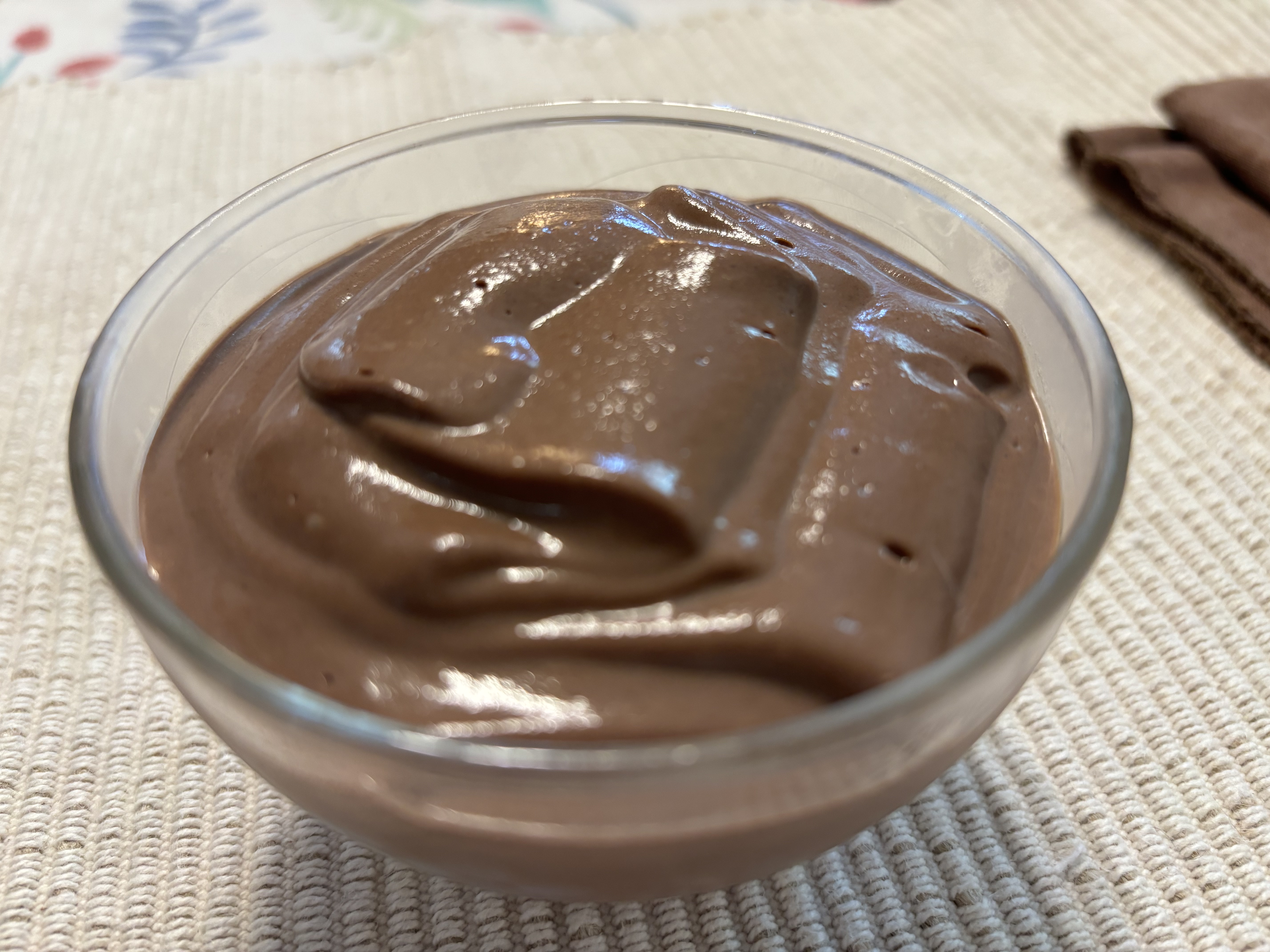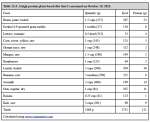Schoenfeld Training Volume Studies | A Critical Evaluation
Did the 2017 Schoenfeld training volume meta-analysis prove that you need to use a high training volume – 10+ sets per muscle group weekly – to achieve your muscular potential? Not by a long shot. I'm not even sure it proved that there exists a dose-response for training volume.
The Schoenfeld Training Volume Meta-Analysis
In 2017, Schoenfeld et al published their meta-analysis concluding that there exists a dose-response to training volume for muscle hypertrophy.1 As shown in the infographic below from Chris Beardsley (Strength & Conditioning Research), higher weekly set volumes appeared associated with greater muscle hypertrophy. Each extra set per week allegedly increased the weekly percentage increase in muscle growth by 0.37%.
First of all, notice that the 2017 Schoenfeld volume training meta-analysis allegedly found a dose-response for rate of improvement. The 2017 Schoenfeld volume training meta-analysis didn't purport to show that low volume produces no gains, only that the percentage rate of gain is directly to the dose of working sets.
According to the 2017 Schoenfeld volume training meta-analysis, the included studies showed that a resistance training volume of less than 5 sets weekly produced a slower rate of improvement than doing 6-9 sets or more than 10 sets weekly. In Table 2 of the 2017 Schoenfeld volume training meta-analysis (below) the authors claim that doing less than 5 sets weekly produced a gain of 5.4%. Doing 9 sets or more produced a change in muscle size of 8.2%, and 10 sets or more 9.8%.
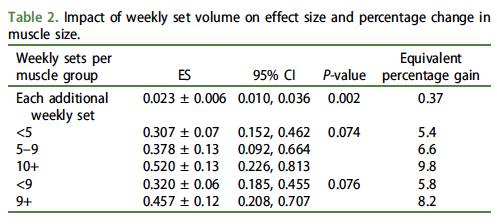
One thing I want to note immediately here is that neither this table nor the text of the paper clearly states the time period during which these percentage gains occurred. Is this 0.37% change in muscle size per day? per week? per month? per quarter? per year? It looks like they are claiming these percentage gains are per week, e.g. performing less than 5 sets per muscle group per week will produce a percentage gain of 5.4% per week, while performing more than 10 sets per muscle group per will will produce a weekly gain of 9.8%. However it is not at all clear, and, as I will discuss below, this rate of gain is not supported by the studies included in the analysis.
On his website, Schoenfeld repeats these numbers:
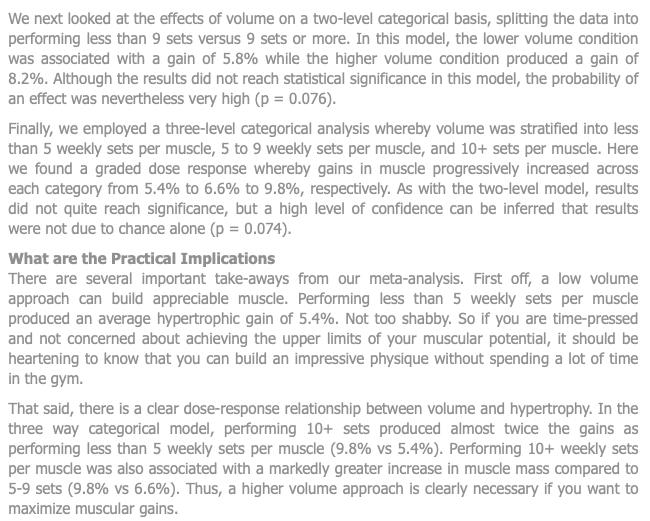
Again, not one word indicating the time period during which these percentage gains are alleged to have occurred in the studies included in the 2017 Schoenfeld volume training meta-analysis. The absence of time specification for the alleged rates of gain is suspicious. A critical reader can't check their work because of this lack of specificity.
As shown above, Schoenfeld says: “So if you are time-pressed and not concerned about achieving the upper limits of your muscular potential, it should be heartening to know that you can build an impressive physique without spending a lot of time in the gym.” In this he implies that although you can "build an impressive physique" with low volume training, he thinks the 2017 Schoenfeld volume training meta-analysis has shown that abbreviated training is insufficient if you are interested in achieving the upper limits of your muscular potential.
But the 2017 Schoenfeld volume training meta-analysis does not show that it is impossible to achieve your muscular potential with low volume high intensity abbreviated training. The data presented in the 2017 Schoenfeld volume training meta-analysis only shows a slower rate of improvement with lower set volume, not that lower set volume makes it impossible to achieve your genetic potential.
Taken at face value, the numbers in imply that someone doing less than 5 sets weekly for a muscle group will eventually reach the same level of development as the person doing 9 or more sets weekly, but will get there a little slower than the person doing 9+ sets weekly, assuming the person using 9+ sets weekly can sustain that level of training without needing extra recovery weeks or incurring injuries that interrupt training progress.
To clarify: Let’s say that some person has a genetic potential to increase his muscle thickness by 200%. For the sake of argument, let's assume the percentage gains in Table 2 are per week (again, I don't know if they are because the paper is unclear). Someone progressing at 5.4% per week will reach the ceiling in about 40 weeks, while someone progressing at 8.2% per week will reach the ceiling in 24 weeks. Gaining more slowly doesn’t mean you won’t reach your potential; it only means you might need more time to reach it. By analogy, if your goal is to traverse 10 miles, you can walk or run. Either way you will travel 10 miles. Going more slowly, in smaller steps per unit time, does not prevent you from reaching the destination.
Fishy Numbers In The Schoenfeld Training Volume Meta-Analysis
That said, I want to expand upon the topic of where the 2017 Schoenfeld volume training meta-analysis obtained these amazing numbers (5.4-8.2%) for percentage gains.
In Table 1 of the 2017 Schoenfeld volume training meta-analysis, the authors report the largest increase in muscle thickness per unit time was in one study (Correa et al 2015) in which an increase of quadriceps muscle thickness of about 20% was reported for a "high volume" (9 sets weekly) group over an 11 week training period. That amounts to about a 1.8% increase in thickness per week.
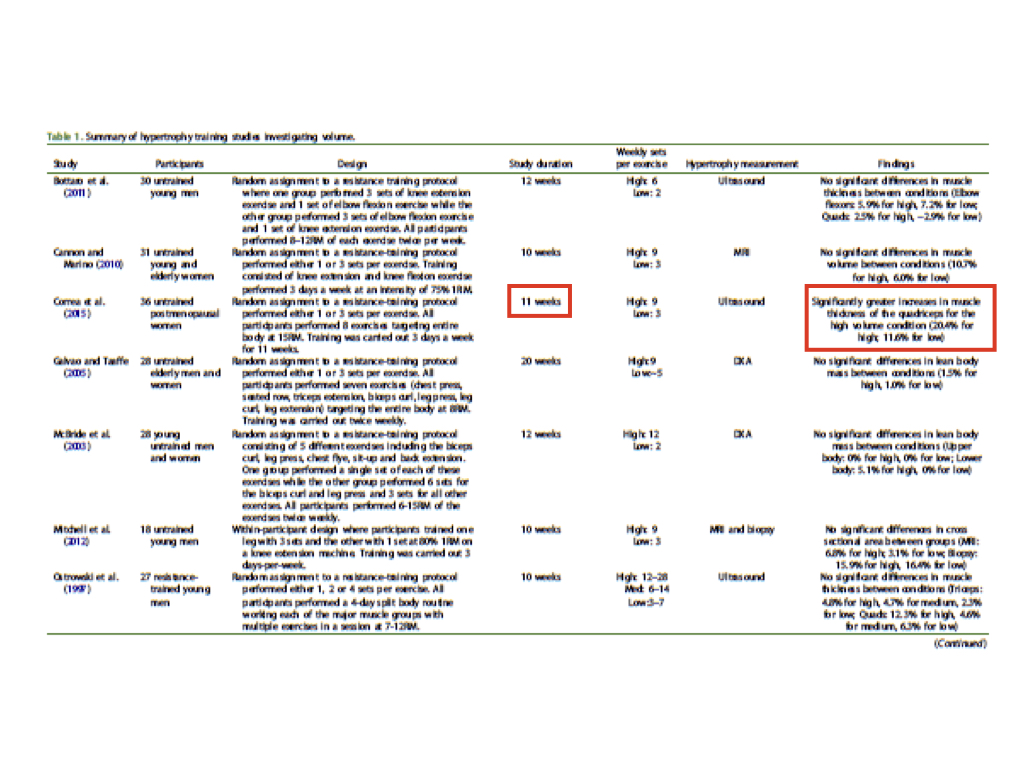
On the other hand, in the study of longest duration – 6 months – the greatest increase in muscle thickness was reported to be 21% (triceps) for the "high volume group" which performed 20 sets per exercise per week (Radaelli, Fleck et al 2014). This amounts to an increase in thickness of 0.875% per week, less than half the gain of the other study.
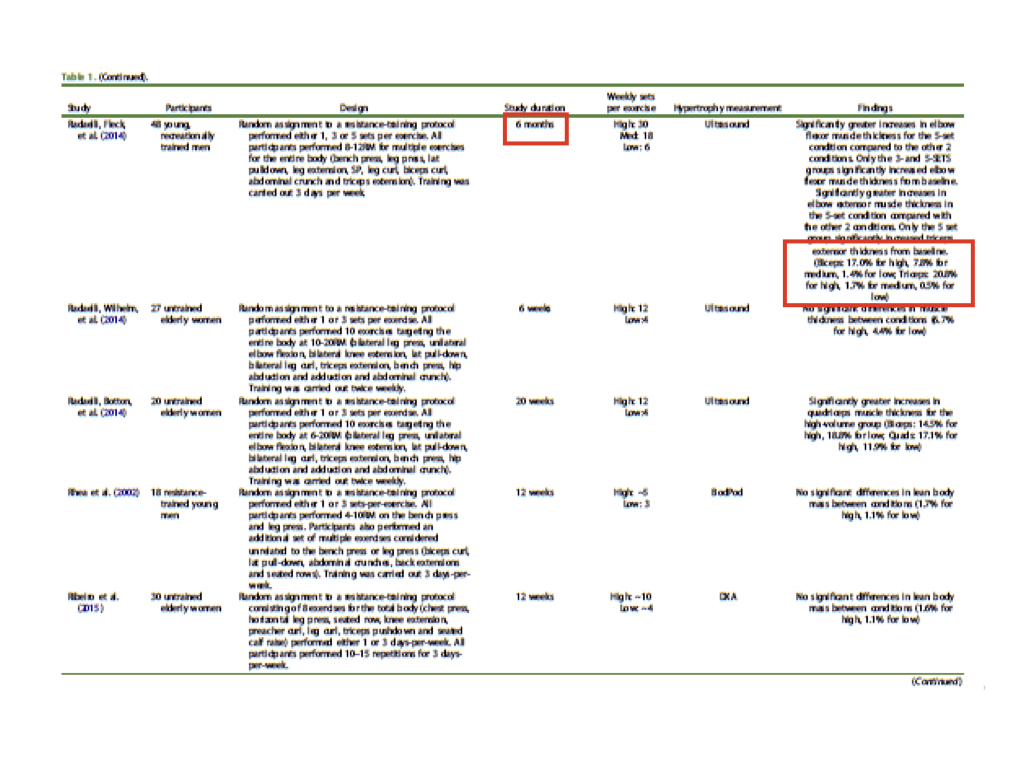
So in the Radaelli, Fleck, et al 2014 study, the triceps increased in thickness by 0.875% per week as a result of performing 20 sets weekly, while in the Correa et al 2015 study highlighted above, the quadriceps increased in thickness by 1.8% per week with only 9 sets weekly. The weekly rate of gain in the study utilizing "only" 9 sets per exercise per week was more than double the rate of gain in the study utilizing 20 sets per exercise per week . By what statistical abracadabra does this support a claim that higher sets = more gains?
Remember, they claimed in Table 2 that the data they analyzed showed that each additional weekly set increased gains by 0.37%. If so, the 20 sets weekly Radaelli, Fleck, et al 2014 study should have produced a much higher gain in its 24 week duration than the the 9 sets weekly Correa et al 2015 study found in its 11 week duration. But despite the Radaelli, Fleck, et al 2014 study being more than twice the duration the Correa et al 2015 study (24 vs 11 weeks respectively), the best result of the Radaelli, Fleck, et al 2014 study was practically speaking no more than the best result of the Correa et al 2015 study (21% gain in muscle thickness vs 20%, respectively). I don't see a way to make this data support the idea that doing more sets per week per muscle group will produce more hypertrophy in the long run.
Moreover, neither of these weekly rates of gain is any where close to the 5.4% gain they claim for 1 to 5 sets weekly, let alone the 8.2% gain they claimed for 9 or more sets weekly. Hence, as I said, it is not clear where these percentage gain numbers (from Table 2 of their paper) come from, or to what unit of time they allegedly pertain.
Real Progression Rates
Most men are subject to the ego which is afflicted with greed, anger and ignorance; greed, anger and ignorance make men dishonest. Everyone wants results yesterday, but building muscle is a long-term project. Almost no one is going to achieve his genetic potential for muscle development in 1 year, regardless of training volume. As I wrote in Primal Fasting:
“Research shows that typical novices to progressive resistance training will only gain on average 1-2 pounds of muscle per month – that’s only one-quarter to one-half pound of muscle per week – with a wide variation between individuals.2 As one passes the novice stage, the rate of gain tapers considerably as the rate of strength gains slows down and the quest to gain muscle requires more patience and persistence over a long term.
“Consider that if you did gain one pound of muscle per week, this would amount to 52 pounds of gain in a year. That would transform the typical 5’10” tall, 154 pound male into a 206 pound individual comparable to an elite bodybuilder. Yet not even elite bodybuilders – who are all of relatively rare genetic stock – gain muscle at this rate.
“To illustrate: Over his 15 year career, 9-time Mr. Olympia Dorian Yates, a genetically gifted and drug-assisted bodybuilder, gained a total of 70 pounds, an average gain of less than 5 pounds per year. Yates gained more per year in the earlier stages and less later, but this illustrates how difficult it is to gain muscular body mass, even for the genetically gifted. In short, if you were to gain an average of 5 pounds of muscle annually – less than half a pound of muscle per month – over several years you would be matching the average rate of muscle gain found in elite bodybuilders who use anabolic steroids."
The greedy ego likes the idea that you can dramatically accelerate your rate of gain – push the river – by doing more than 10 sets per muscle group per week, but I don't think the 2017 Schoenfeld volume training meta-analysis provided good evidence that higher volume training programs (≥6 sets per muscle group weekly) will markedly increase your rate of gain over the short or long term.
Indeed, there exist studies showing quite high rates of lean mass gains with as little as 3 sets per exercise weekly.
McLester et al compared the effects of doing a single set of 9 different exercises thrice weekly to those of doing 3 sets to failure of the same exercises once weekly with subjects who had a minimum of 12 weeks of training experience.3 In this study, men had a mean training experience of 4-6 years, and for women 4-9 years. The routine consisted of
- Supine bench press (pectorals, deltoids, triceps)
- Elbow extension (triceps)
- Lateral raise (deltoids)
- Seated pull down (latissimus dorsi, biceps, deltoids)
- Elbow flexion (biceps)
- Leg press (gluteus maximus, quadriceps, hamstrings)
- Knee extension (quadriceps)
- Knee flexion (hamstrings)
- Standing heel raise (gastrocnemius)
Greater increases in both strength and muscle mass occurred in the group that did one set of each exercise thrice weekly. The group training with 3 sets once weekly obtained about 62% of the strength gains but less than one-quarter of the increase in lean mass ( 1 kg vs. 4.6 kg) obtained by the group that trained with 1 set thrice weekly. The point here is that this study reported a lean mass gain of 4.6 kg (10 pounds) over 12 weeks of training. Once again, if this rate of gain was sustained over 52 weeks, a man would gain 43 pounds of lean tissue, which would be phenomenal. It is highly unlikely that the rate of gain would double by performing twice as many sets (i.e. 6 sets per exercise weekly), let alone 5 to 10 times as many sets.
It bears noting that in this McLester study, the group that trained only once weekly reported greater muscle soreness which the authors suggested may have been the result of greater detraining between sessions. Since the once weekly group had more soreness and less hypertrophy, this suggests that the once weekly subjects did not adapt to the exercise, with the result that more of the post training muscle protein synthesis was directed to repairing the weekly muscle damage rather than growing new muscle tissue (see reference 4). This study suggested that when weekly volume is held constant (3 sets per week per exercise), spreading that volume out over 3 sessions may produce more strength and hypertrophy than doing it all in one session.
This brings me to an important point: since we now know that muscle damage not only does not stimulate but in fact retards hypertrophy,4 the ideal hypertrophy program would strongly stimulate hypertrophy via high levels of muscle tension while excluding muscle damage.
Less muscle damage means less recovery time between sessions. If training sessions do minimal damage, you can train more frequently. The more frequently one trains, the more often you stimulate protein synthesis.
It is certain that the more work you do in a session, the more damage you will do to a muscle and the more resources you will have to recover between sessions. In other words, more training volume inevitably dictates more recovery time (volume and frequency are inversely related), which means higher volume dictates lower frequency of stimulus for protein synthesis. Since a single training session can only increase protein synthesis for about 36-72 hours, and it takes about 48 hours to recover glycogen stores in a trained muscle, the ideal routine would minimize or completely avoid muscle damage by implementing a minimal volume (probably 1-3 sets per muscle group) of high tension, which would allow application of the stimulus once every 48 to 96 hours.5, 6, 7, 8
Schoenfeld's 2018 Volume Training Study
In 2018 Schoenfeld and colleagues published another study prescribing 1, 3 or 5 sets per exercise for each of seven exercises: flat barbell bench press, barbell military press, wide grip lateral pulldown, seated cable row, barbell back squat, machine leg press, and unilateral machine leg extension.9
According to their report the 8-12 repetitions for each set were "carried out in a controlled fashion, with a concentric action of approximately 1 s and an eccentric action of approximately 2 s." The subjects were given 90 s rest between sets and 120 s between exercises. At a mean of 30 s per set (10 reps x 3 s/rep), 45 sets would consume 22.5 minutes alone. Rest periods amount to 480 s (8 minutes) per exercise, for a total of 56 minutes spent resting during each training session. The entire routine would consume 78.5 minutes if performed exactly as stated.
According to the 2018 Schoenfeld volume training study, "Average training time per session was approximately 13 min for 1SET, approximately 40 min for 3SET, and approximately 68 min for 5SET." So the 5SET group did 5 times as much work and spent 5 times as much time on training. What did they get for their extra effort? According to Schoenfeld and colleagues:
- "There was no significant difference between groups in squat 1RM improvement, and evidence favored the null model "
- "There was no significant difference between groups in bench 1RM improvement.."
- "There was no significant difference between groups in bench endurance improvement.."
- Five set group had a "significant" gain in bicep thickness compared to the one set group but not in comparison to the three set group.
- "There was no significant difference between groups in the improvement in triceps thickness, and evidence favored the null model."
- The higher volume groups had significantly greater increases in thigh muscle thickness (rectus femoris and vastus lateralis).
So the high volume group spent 5 times as much time training, but obtained no additional gains in strength and only some significant differences in hypertrophy. Moreover, I am a little suspicious of the 2018 Schoenfeld volume training study's data on hypertrophy. Take a look at the muscle thickness data in this table from the study:
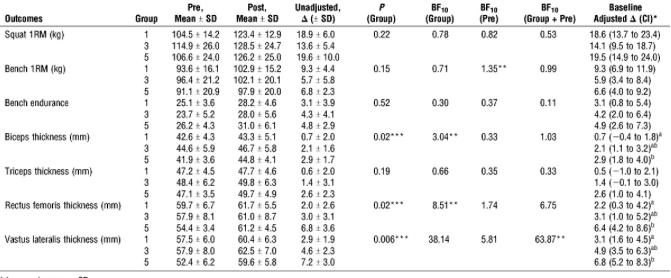
Examine the pre- and post- data for biceps, triceps, rectus femoris and vastus lateralis thickness. Notice anything special? I do.
For biceps, the pre-training measures show that the 1 set group mean is 42.6, which increased with training to 43.3; while the 5 set group pre-training mean is 41.9, which increased to 44.8. The 1 set group started out with greater thickness, and both groups had hypertrophy, but the 5 set group had greater increase.
For triceps, the 1 set group started out at 47.2, ended at 47.7; the 5 set group started out at 47.1 and ended at 49.7. The groups started out with similar tricep thickness, and both groups had hypertrophy, but the 5 set group gained only a little more. Yet as mentioned above there was statistically no significant difference in rate of gain in triceps thickness according to Schoenfeld et al.
For rectus femoris, the 1 set group started at 59.7, and ended at 61.7; the 5 set group started at 54.4 and ended at 61.2. The 1 set group started out with greater thickness, both groups gained, and the 5 set group made the greatest gain, but in fact by the end of the training period the 5 set group and the 1 set group had similar rectus femoris thickness.
For vastus lateralis, the 1 set group started at 57.5 and ended at 60.4; the 5 set group started at 52.4 and ended at 59.6, about the same as the 1 set group. The 1 set group started out more developed, and both groups gained muscle thickness, but at the end the 5 set group and 1 set group had similar vastus lateralis thickness.
Only subjects who had at least 1 year of experience training at least thrice weekly were eligible for the study. To me it looks like the greater gains in the 5 set group for biceps, rectus femoris and vastus lateralis could partly be due to the fact that the subjects in the 5 set group started with less development in those muscle groups than the subjects in the 1 set group. In other words, somehow the 1 set group got filled with subjects who already had significantly greater development of those muscles – particularly the thighs – than the subjects assigned to the 5 set group, so the subjects in the 1 set group may have had less room to grow regardless of training volume.
Another possibility is that subjects who had previous training experience were accustomed to doing multiple sets, since that is the norm. When assigned to doing only one set per exercise, they continued to perform that one set with the intensity of effort that they were accustomed to applying in their multiple set routines, i.e. holding back effort on the first set in preparation for multiple sets. However now they did not have multiple sets to make up for their lackluster effort on the first set. Consequently the subjects who performed 3 or 5 sets achieved a greater fatigue in the muscles leading to higher levels of muscle tension in the later sets than the 1 set group achieved in their single set. I find this plausible given the protocol of 1 s concentric and 2 s eccentric cadence, which resulted in a time under high tension of not more than 36 seconds per set. In my approach, a properly performed high intensity set generally involves at least 40 seconds of time under load, with a slower movement eccentric velocity and pauses in the the most difficult ranges of motion, which leads to greater muscular tension and fatigue and therefore a greater recruitment of the high threshold fibers responsible for hypertrophy in that one set than in a single set performed with less precise technique.
In any case, I find it suspicious that the 1 set group started with greater rectus femoris and vastus lateralis development/thickness, and the 5 set group just barely matched the 1 set group for rectus femoris and vastus lateralis development/thickness after 8 weeks of training. Thus two of the four significant differences in hypertrophy outcomes in this study were in those muscle groups where the 5 set group started with significantly less muscle thickness. Plus, regardless of the alleged superiority of performing 5 sets weekly per exercise for hypertrophy, the group that did perform that volume ended up with rectus femoris and vastus lateralis thickness practically the same as those of the 1 set group. They did 5 times more work but in the final analysis their thigh muscles weren't any thicker than those of the group that did only 1 set per exercise.
Finally, I find it interesting that this study included no body composition measurements. The authors state that they measured body mass to the nearest 0.1 kg on a calibrated scale, but they provide no data on body mass anywhere in the report. Did anyone gain lean mass or lose fat mass in this study? I don't know. The absence of report this data leaves me suspecting that the data was not favorable to their conclusion that the 5 set program produced superior hypertrophy results. Conflict between data on lean mass gains and muscle thickness gains could suggest or reveal that some of the apparent superiority of the 5 set group for muscle thickness gains was due to measurement errors.
In summary, this study did not impress me much. The 1 set group obtained the essentially the same strength gains as the 5 set group, and also obtained substantial hypertrophy over 8 weeks with one-fifth the training time investment, despite using what is in my estimation a suboptimal exercise performance protocol.
If You Hurry You Might Get There Later
Even if doing a higher volume of exercise can accelerate your gaining rate over the short term, over the long term you might not reach the goal faster by trying to rush the muscle gain process. Although doing more volume might produce greater results in short-term studies, since muscle growth is a very slow process (as discussed above) in the long term real world application you will get the greatest results from the program you can most easily sustain long term without burn out or injury.
When you look at the time periods of the studies included in the Schoenfeld training volume meta-analysis1, one lasted 6 weeks, three lasted 10 weeks, two lasted 11 weeks, five lasted 12 weeks, one lasted 14 weeks, two lasted 20 weeks, and one lasted 6 months. Twelve of 15 studies lasted no more than 14 weeks, or about 3 months.
My point here is simply that even if doing 9 or more weekly sets per muscle group produced better results than 3 weekly sets per muscle group over a period of 12 weeks, this doesn’t predict that such gains would continue to occur for 30, 40, 50 or more weeks. It is certain that 9 weekly sets will produce greater fatigue accumulation over 12 weeks than only 3 weekly sets. This greater fatigue will eventually dictate a need for a training vacation.
You might be able to do 3 weekly sets (1 set thrice weekly) indefinitely without any need for a vacation. The higher your training volume, the more likely and often you will need vacations from training.
With a higher training volume, you are also more likely to be injured – either acute injury or chronic over use injury. When you take a vacation or “deload” because of fatigue or injury, you are not stimulating protein synthesis at all. Meanwhile the guy doing only 5-10 sets per session continues to train and to gain.
The more sets you do per training session, the more difficult it is to sustain the training program long-term. Longer sessions are more difficult to fit into your life, and they require more energy input as well. A basic full body training program with 5-10 exercises done properly for one set (40-90 s) each will take only 20-30 minutes to complete. Triple the sets and you will spend more like 1.5 hours for each training session.
Using a lower volume (1-3 sets per muscle group) may produce less protein synthesis per training session, but you can do the sessions more frequently (2-3 times weekly), will not get overuse injuries and will not need frequent vacations from hard training to recover, so over the long term you may end up with greater cumulative muscle growth than the greedy individual who tries to force rapid growth by doing what are most likely redundant sets, provided the first set is done with precision and sufficient intensity.
When I was a teenager, I trained with high volume programs – 10+ sets weekly per muscle group – for several years. On those programs I never produced results any better than I have produced with low volume programs of 2-6 sets weekly per muscle group.
Unlike Schoenfeld and colleagues, Morton and colleagues have concluded that intensity of effort is the primary determinant of hypertrophic outcomes, that anything more than 10 repetitions per week provides "adequate volume" for hypertrophy, which can only be "slightly improved" with additional volume up to 15 sets per week.10
In short, I still am waiting for good evidence that doing a high volume of sets of resistance training will markedly improve the hypertrophy results of a program in the long run.
Notes
1. Schoenfeld BJ, Ogborn D, Krieger JW. Dose-response relationship between weekly resistance training volume and increases in muscle mass: A systematic review and meta-analysis. J Sports Sci 2016; DOI: 10.1080/02640414.2016.1210197.
2. Cureton KJ, et al., “Muscle hypertrophy in men and women,” Medicine and Science in Sports and Exercise 1988; 20(4): 338-344.
3. McLester JR, Bishop P, Guilliams ME. Comparison of 1 Day and 3 Days Per Week of Equal-Volume Resistance Training in Experienced Subjects. Journal of Strength and Conditioning Research 2000;14(3):273-281.
4. Damas F, Phillips SM, Libardi CA, et al. Resistance training‐induced changes in integrated myofibrillar protein synthesis are related to hypertrophy only after attenuation of muscle damage. The Journal of Physiology. 2016;594(18):5209-5222. doi:10.1113/JP272472.
<https://www.ncbi.nlm.nih.gov/pmc/articles/PMC5023708/#tjp7344-tbl-0001>
5. MacDougall JD, Gibala MJ, Tanopolski MA, et al. The Time Course for Elevated Muscle Protein Synthesis Following Heavy Resistance Exercise. Can J Appl Physiol 1995;20:480-86.
6. Miller BF, Olesen JL, Hansen M, et al. Coordinated collagen and muscle protein synthesis in human patella tendon and quadriceps muscle after exercise. J Physiol. 2005;567(Pt 3):1021-33.
7. Gumucio JP, Sugg KB, Mendias CL. TGF-β superfamily signaling in muscle and tendon adaptation to resistance exercise. Exerc Sport Sci Rev. 2015;43(2):93-9.
8. Dankel, S., Mattocks, K., Jessee, M., Buckner, S., Mouser, J., Counts, B., Laurentino, G., & Loenneke, J. (2016). Frequency: The Overlooked Resistance Training Variable for Inducing Muscle Hypertrophy?. Sports Medicine, 47(5), 799-805.
9. Schoenfeld B, Contreras B, Krieger J, et al. Resistance Training Volume Enhances Muscle Hypertrophy but not Strength in Trained Men. Med Sci Sports Exerc 2019 Jan;51(1):94-103. <https://journals.lww.com/acsm-msse/Fulltext/2019/01000/Resistance_Training_Volume_Enhances_Muscle.13.aspx>
10. Robert W Morton, Lauren Colenso-Semple, Stuart M Phillips. Training for strength and hypertrophy: an evidence-based approach. Current Opinion in Physiology, Volume 11, October 2019, Pages 149-150
Recent Articles
-
Ancient Roman Soldier Diet
Apr 14, 25 05:19 PM
A discussion of the ancient Roman soldier diet, its staple foods and nutritional value, and a vegan minimalist version. -
High Protein Chocolate Tofu Pudding
Jul 01, 24 12:41 PM
A delicious high protein chocolate tofu pudding. -
Vegan Macrobiotic Diet For Psoriasis
Sep 05, 23 06:36 PM
Vegan macrobiotic diet for psoriasis. My progress healing psoriasis with a vegan macrobiotic diet. -
How Every Disease Develops
Aug 04, 23 06:22 PM
How every disease develops over time, according to macrobiotic medicine. -
Why Do People Quit Being Vegan?
Jun 28, 23 08:04 PM
Why do people quit being vegan? How peer pressure and ego conspire against vegans. -
Powered By Plants
Mar 16, 23 08:01 PM
Powered By Plants is a book in which I have presented a lot of scientific evidence that humans are designed by Nature for a whole foods plant-based diet. -
Carnism Versus Libertarianism
Dec 30, 22 01:55 PM
Carnism Versus Libertarianism is an e-book demonstrating that carnism is in principle incompatible with libertarianism, voluntaryism, and anarchism. -
The Most Dangerous Superstition Book Review
Nov 15, 22 08:46 PM
Review of the book The Most Dangerous Superstition by Larken Rose.

